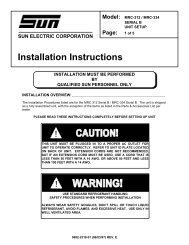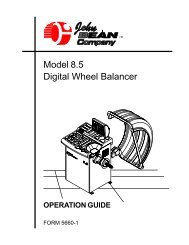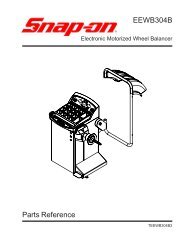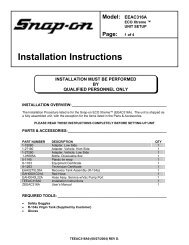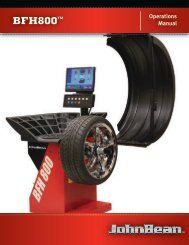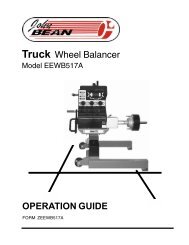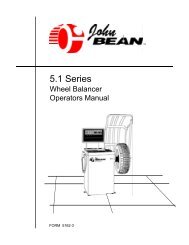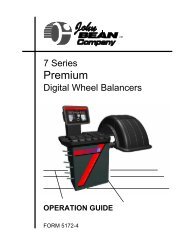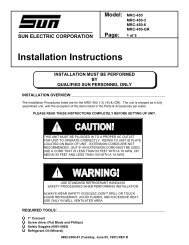here - Snap-on Equipment
here - Snap-on Equipment
here - Snap-on Equipment
You also want an ePaper? Increase the reach of your titles
YUMPU automatically turns print PDFs into web optimized ePapers that Google loves.
Introducti<strong>on</strong><br />
Refrigerant Gases<br />
Halogens are any of the five elements (fluorine, chlorine,<br />
bromine, iodine and astatine) that form part of group 7a of the<br />
Periodic Table of Elements. The fluorine and chlorine elements<br />
of this family are used to create a methane organic compound<br />
used to form dichlorodifluoromethane (CCL 2 F 2 ), a halogenated<br />
hydrocarb<strong>on</strong> called CFC-12 (chlorofluorocarb<strong>on</strong> 12). This<br />
refrigerant gas is comm<strong>on</strong>ly known as Refrigerant-12, or R-12,<br />
and has been used as a refrigerant in mobile air c<strong>on</strong>diti<strong>on</strong>ing<br />
systems for many years.<br />
The new refrigerant in the halogenated hydrocarb<strong>on</strong> family,<br />
HFC-134a (CH 2 FCF 3 ), or R-134a, is now being incorporated in<br />
mobile air c<strong>on</strong>diti<strong>on</strong>ing systems. HFC stands for<br />
hydrofluorocarb<strong>on</strong>.<br />
The envir<strong>on</strong>mental impact of mobile air c<strong>on</strong>diti<strong>on</strong>ing refrigerant<br />
c<strong>on</strong>taining chlorine (R-12) has caused regulatory acti<strong>on</strong> that will<br />
eventually eliminate the use of such products. Regulatory<br />
acti<strong>on</strong> is necessary because when the chlorine c<strong>on</strong>tent in R-12<br />
is exposed to the atmosp<str<strong>on</strong>g>here</str<strong>on</strong>g>:<br />
• It depletes the protective oz<strong>on</strong>e layer in the atmosp<str<strong>on</strong>g>here</str<strong>on</strong>g>,<br />
• It has relatively high global warming potential, and<br />
• Its l<strong>on</strong>g atmospheric lifetime is approximately 120 years.<br />
R-134a has been developed for new vehicle producti<strong>on</strong> but<br />
does not replace or directly substitute for R-12 in existing<br />
vehicles. R-134a does not c<strong>on</strong>tain chlorine, does not deplete<br />
the oz<strong>on</strong>e layer in the atmosp<str<strong>on</strong>g>here</str<strong>on</strong>g> and has an atmospheric<br />
lifetime of about 15.5 years.<br />
Envir<strong>on</strong>mental Protecti<strong>on</strong> Agency (EPA) and state regulati<strong>on</strong>s<br />
specify that:<br />
• Provisi<strong>on</strong>s be made to certify all air c<strong>on</strong>diti<strong>on</strong>ing service,<br />
installati<strong>on</strong> and repair pers<strong>on</strong>nel,<br />
• Refrigerant be recovered, recycled or reclaimed from<br />
automotive air c<strong>on</strong>diti<strong>on</strong>ing systems, instead of allowing<br />
vapors to be expelled, or vented, into the atmosp<str<strong>on</strong>g>here</str<strong>on</strong>g>, and<br />
• Refrigerant be recycled and reused, or properly disposed of,<br />
instead of allowing vapors to be expelled, or vented, into the<br />
atmosp<str<strong>on</strong>g>here</str<strong>on</strong>g>.<br />
Mobile air c<strong>on</strong>diti<strong>on</strong>ing service, installati<strong>on</strong> and repair<br />
technicians must be qualified and certified.<br />
1-2



